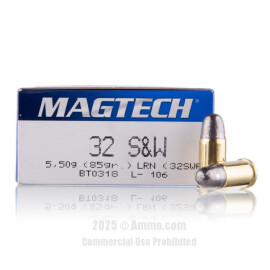
32 S&W Ammo For Sale
Overview of 32 S&W Ammo
The .32 Smith & Wesson is a small pistol cartridge intended for use as personal protection at close range. The S&W Model 1½ break-top revolver was the first platform for the cartridge. Intended for use at “card table distances,” the .32 S&W was considered the smallest cartridge acceptable for personal protection in its time. It fit the bill for being a gentleman’s vest gun – a small handgun for the vest pocket that was especially popular in the late 19th century and early 20th century. It was later surpassed by the .32 ACP. The .32 S&W may also be referred to as the .32 S&W Short.
32 S&W Ballistics: Chart of Average 32 S&W Ballistics
Collectors still roam the aisles at gun shows and auctions searching for .32 Smith & Wesson firearms. There are few available on the market, but they can be found. The ammo – which is still possible to buy from some of the major manufacturers including Remington – can be fired in revolvers chambered for the .32 H&R Magnum and for the .327 Federal Magnum.
The .32 S&W is not exactly poised for a comeback, but will likely continue to be manufactured as the old S&W 1½. Afterall, Iver Johnson revolvers chambered for this cartridge will still be shooting for years to come.
Note: This information comes from the manufacturer and is for informational purposes only. The actual ballistics obtained with your firearm can vary considerably from the advertised ballistics. Also, ballistics can vary from lot to lot with the same brand and type load.
| 32 S&W Bullet WEIGHT | Muzzle VELOCITY (fps) | Muzzle ENERGY (ft. lbs.) | Mid-Range TRAJECTORY (in.) | Barrel Length (in.) | |||||
|---|---|---|---|---|---|---|---|---|---|
| 88 Grain | 680 | 645 | 610 | 90 | 80 | 75 | 2.5 | 10.5 | 3" |
Customer Reviews
-
mikek said:
C&R collectors work hard to hold on to these old revolvers. Like any hobby it saves part of US History. To be able to fire these relics is a real bonus. It also deters owners from trying to use hot ammo just to fire them. Thank you MagTech and Remmington.
-
none said:
Ammo performed well, no signs of excessive pressure,powder build up,or muzzle flash.









